Welcome to my experiment in baking with beer yeast you guys. Especially if you are a brewer, I can wholeheartedly recommend using dry brewing yeast for bread baking. You can also learn more about the function of yeast in general
More baking with brewers yeast with my Champagne Yeast Pita and Champagne Yeast Brioche.
For ease of browsing, you can find all my bread recipes in one place. Thanks for being here!

Want to refer back to this post?
Baking with Brewers’ Yeast Pinterest Link
The beginnings of a plan
Sometimes I get crazy ideas. Sometimes these ideas don’t work out. But a few weeks ago, I actually had a good crazy idea. I thought that it would be Fun to experiment with different strains of brewers’ yeast in my bread.
Pastry Chef Online Participates in Affiliate Programs. If you make a purchase through one of my links, I may earn a small commission. For more information click to read my disclosure policy
Granted, bakers’ yeast has been optimized for baking, so I guess it’s a fan of the particular sugars present in wheat flour.
But all yeasts eat sugars and expel carbon dioxide and alcohol. I figured that trying to bake with beer yeast might be a fun experiment.
The Beloved and I took a trip out to the local home brew store, American Brewmaster. I came home with a veritable Treasure Trove of goodies.
I bought three kinds of yeast, some Belgian candy sugar (which sat on the sidelines during this experiment–I kind of forgot about it), and some dry malt extract.
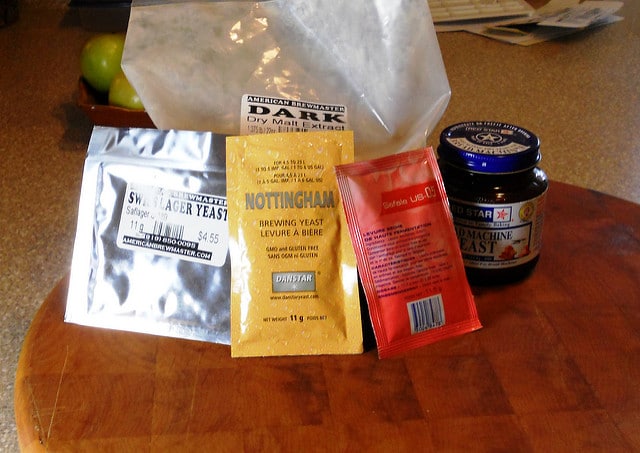
I was going to get the syrupy malt extract, but The Guy told me that it is Very Susceptible to bacterial infiltration and just to get the dried. I sullenly accepted his advice.
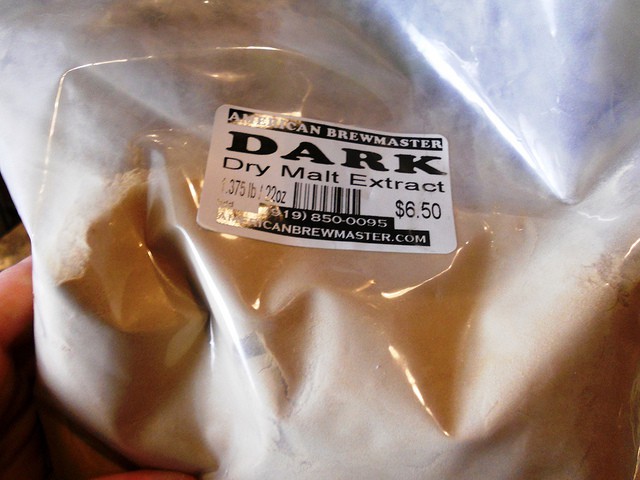
So, then, there they were. All my ingredients. Facing me. Day after day. Finally, after a couple of weeks, I broke down and decided that That Day was The Day. I decided to be kind of scientific-y about the whole thing.
Getting started (and get in touch)
I used exactly the same ingredients in the same proportions for each dough. The only difference was the type of yeast I used.
I also labeled everything and gave all the dough the same amount of rise time both on the counter and in the fridge.
Read on to learn everything you want to know about baking with brewers yeast.
And if you don’t find what you’re looking for, email me. Seriously.
About this dough
Incidentally, this is a fantastic wet-ish dough. The long, uber-slow rise helps to develop some really nice chew and flavor, even using all purpose flour.
Even if you’re not feeling Up to the whole brewers’ yeast thing, this recipe makes a great loaf that weighs about 1 1/2 pounds.
This recipe yields a chewy bread with a reasonably open crumb. If you are looking for a sandwich bread, try my Spent Grain Bread and use brewers’ yeast rather than bread yeast.
Supplies you may need
Here are some recommendations for brewer’s yeast and other products and ingredients you can use in baking bread to enhance flavor or switch up the flavor profile a bit. Not all your experiments will be perfect, but you’ll always learn something.
Some good yeasts to start with are SafAle Ale Yeast, the Nottingham yeast (the one that made the bread smell like oatmeal), and of course the lager yeast, that loves the cold anyway.
You may also want to check out this Mangrove Jack’s US West Coast dry yeast.
Consider picking up some malt powder or even some rock sugar for feeding the yeast. I also have added a link for a reliable instant read thermometer, a high quality but reasonably priced kitchen scale, and a lamé for scoring bread.
I consider the thermometer and the scale to be essential kitchen tools, whether baking bread of not. And the lamé is certainly nice to have if you do a lot of bread baking.
Basic bread ingredients for this experiment (per loaf):
- 15 oz all purpose flour (I used King Arthur)
- 9 oz cool warm-ish water (about 100F)
- 1 teaspoon salt
- 1 teaspoon dry malt extract (feel free to substitute molasses, honey, sugar, maple syrup–whatever type of sugar you want)
- 1/4 teaspoon dried yeast
Procedure
NOTE: I made 4 separate loaves with 15 oz flour each to make it easier to blend the yeast into each loaf.
First, weigh out your flour.
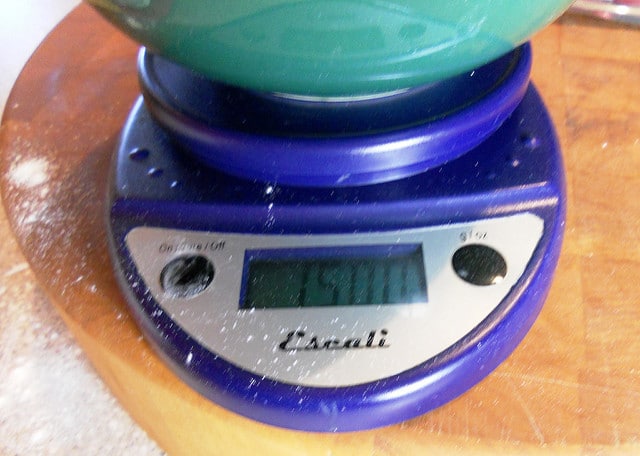
Choose your yeast. You’ll only be using 1/4 teaspoon.
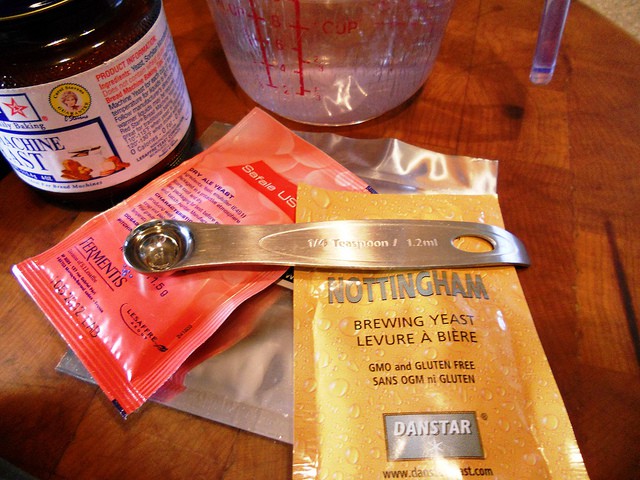
Salt and malt extract go into each loaf.
Would you like to save this post?
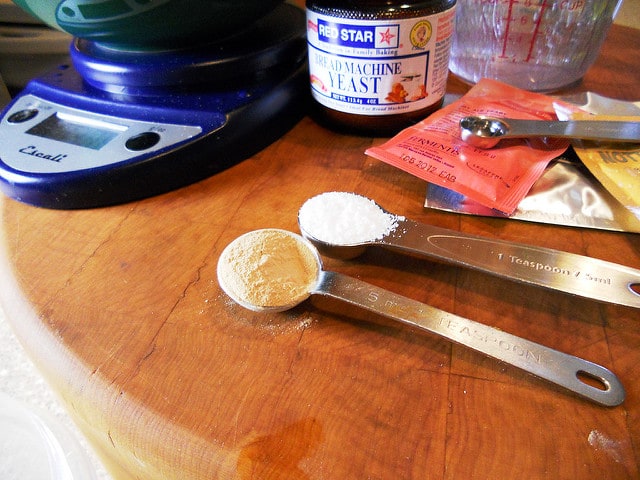
And 9 ounces of water. If you don’t have a scale or a liquid measure with accurate markings, use 1 cup (carefully filled to the top) plus 2 tablespoons of water. (Again, please buy a scale.)
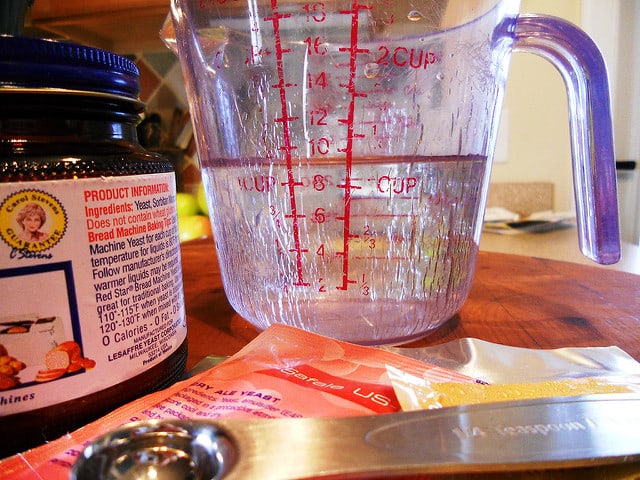
Whisk together dry ingredients in a mixing bowl. Turn on your mixer (fitted with the dough hook) to low speed and mix for three minutes.
Raise the speed to medium and knead for seven minutes.
**What follows is the rising schedule I used to bring out as much flavor as possible. If you don’t have the time, increase the yeast to 1-2 teaspoons and let it rise once until doubled.
Punch down, shape, let rise again and then bake. Let the last rise happen in a greased 1 pound loaf pan if you want a taller loaf. Since this dough is pretty loose, it tends to spread a bit.
Apocalyptic rising schedule
- Put each dough in a 1-gallon zip top bag. Label (!) and let rise in a cool kitchen (65F) for 3 1/2 hours
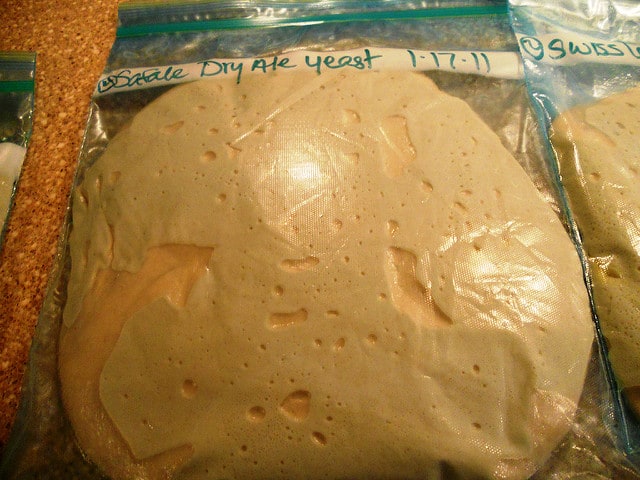
- Transfer to the fridge–don’t stack them–and let rise for a long over-night. Mine rose for about 10 hours.
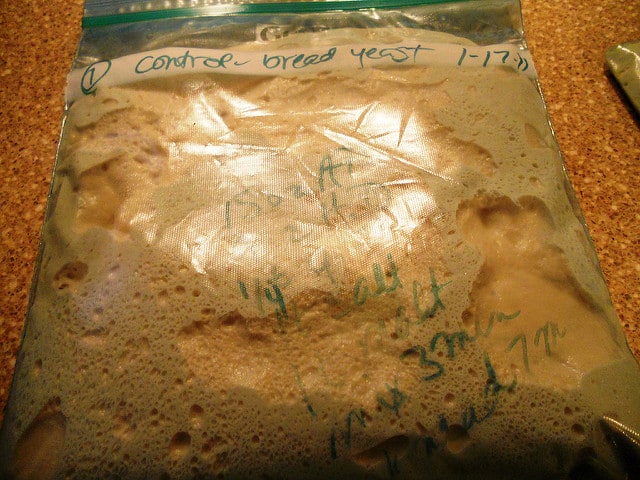
- In the morning, put them back on the counter for 3 hours.
- Oil your hands. Take each piece of dough out of its pouch. Punch each piece down and knead a few times to redistribute the yeast. Round, oil and cover. Let rise again for 3 hours.
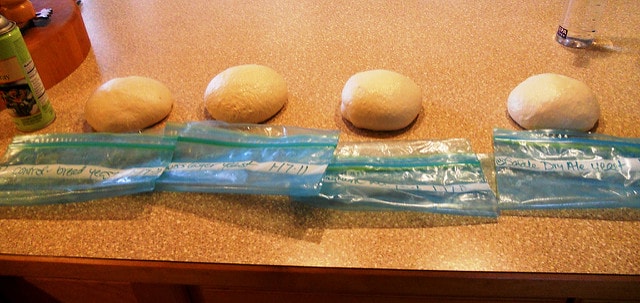
- Punch down again, press out all (most) of the large air bubbles, and shape. Oil and cover. Let rise on a prepared baking sheet for another 1 1/2 hours OR
- Shape lightly and don’t press out the gases for a loaf with a more “artisinal” open-crumbed texture.
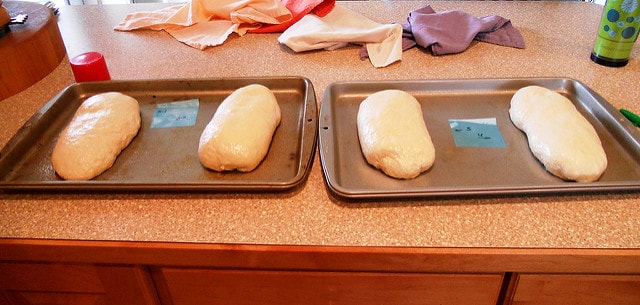
- Slash with your lame (if you want) and bake at 350F for 25 minutes.
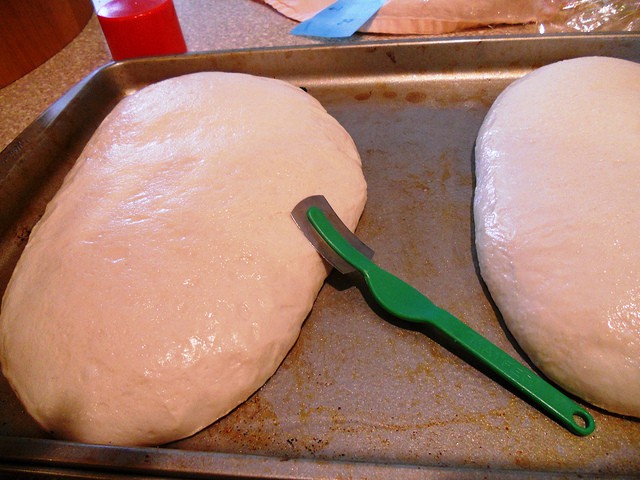
- Remove from baking sheets and finish them directly on the racks for another 10-15 minutes, or until the internal temperature is 200-205F.
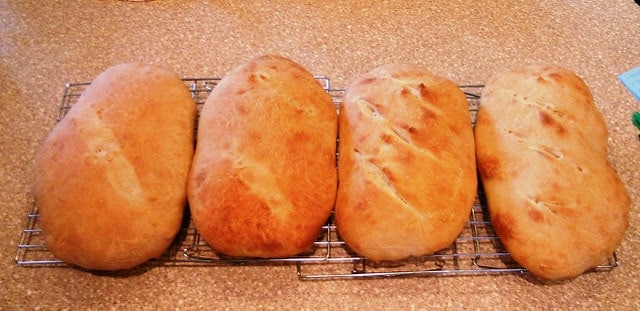
- Let cool completely on racks. Slice and freeze.
Since this dough is so slack and sticky, make sure to oil (or spray Pam on) your hands to keep it from sticking (to you or the counter) or to help you resist the urge to add more flour.
You Can’t Make This with Brewers Yeast Supplement
I had a reader message me to say their yeast wasn’t working. Then they sent a photo of a brewers yeast supplement they were trying to use.
Please note: the supplement version of brewers yeast will not work in this recipe or any other bread recipe, if you want to use it as the leavening agent.
This type of nutritional supplement is an inactive form of yeast. Otherwise, you’d have a tummy full of alcohol and would be burping carbon dioxide for who knows how long!
Takeaways
So, what did I learn from my experiment of baking with beer yeast? Well, I learned lots of stuff.
- Each yeast lends a slightly different character to the dough.
- The differences that I noted were fairly subtle. I could only really detect them in side by side tests.
- Lager yeast definitely enjoys being in the fridge. Lagers ferment at a lower temperature than ales, so it makes sense that the lager yeast was pretty happy in the fridge and in our 65F kitchen.
- Bread made with Nottingham ale yeast smells like oatmeal. This is a Very Good Thing.
- The loaf made with the bread yeast (the Control Loaf), while still tasty, was the least interesting of the four loaves. Sorry, bread yeast. I can absolutely Quit You.
- This base recipe would absolutely make the best baguettes. Try it. A twitter friend uses the Safale Dry Ale yeast in her baguettes. It yielded a pretty fine and regular crumb–perfect for baguettes.
- You can never have too much bread in the house.
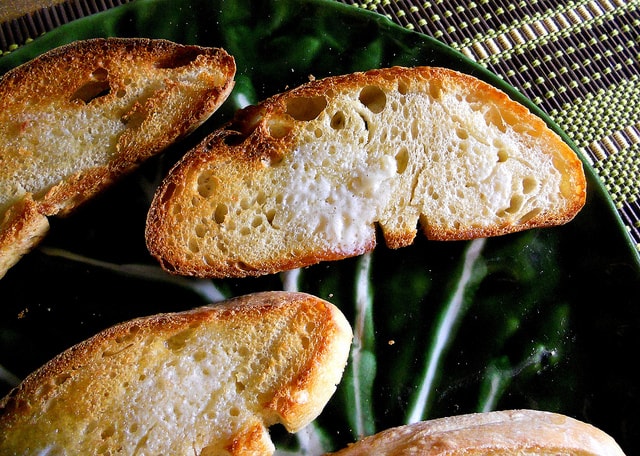
Don't let its small price and small size fool you. The Escali Primo is an accurate and easy-to-use food scale that I have used for years. It's easy to store, easy to use, has a tare function, and easily switches between grams and ounces/pounds for accurate measurements.
It will help me and other readers so much if you take a moment to rate and leave a review for this recipe.
You can use the stars to rate 1-5 (5 is best), and leave a review in the comments. It helps me make adjustments if any are needed, and comments help others decide whether the recipe is worth making.
Other ways to share include pinning, and/or sharing on your favorite social media platform.
Thank you so much for taking the time!


Bread Made with Beer Yeast
Would you like to save this post?
Ingredients
- 15 oz all purpose flour I used King Arthur
- 9 oz water just above body temperature
- 1 teaspoon salt
- 1 teaspoon dry malt extract or powder or sweetener of choice
- ¼ teaspoon active dry yeast
Instructions
- Whisk together dry ingredients in a mixing bowl.
- Pour the water on top.
- Turn on your mixer (fitted with the dough hook) to low speed and mix for three minutes.
- Raise the speed to medium and knead for seven minutes.
Rising Schedule I Used
- Put dough in a 1-gallon zip top bag. (See Notes) Label (!) and let rise in a cool kitchen (65F) for 3 1/2 hours
- Transfer to the fridge and let rise for a long over-night. Mine rose for about 10 hours.
- In the morning, put the dough still in the bag on the counter for 3 hours.
- Take dough out of its pouch.
- Oil your hands, and punch down and knead a few times to redistribute the yeast. Round the loaf, oil and cover.
- Let rise again for 3 hours.
- Punch down again, press out all (most) of the large air bubbles, and shape.
- Oil and cover. Let rise on a prepared baking sheet for another 1 1/2 hours
- If you prefer, you can shape lightly and don’t press out the gases for a loaf with a more “artisinal” open-crumbed texture.
- Slash (if you want) and bake at 350F for 25 minutes.
- Remove from baking sheet and finish the loaf directly on the rack for another 10-15 minutes, or until the internal temperature is 200-205F.
- Let cool completely on rack.
- Slice and enjoy.
Did You Make Any Changes?
Notes
To Freeze
If you do not intend to eat or share the whole loaf within a day, slice it and then freeze in a heavy duty zip top bag. Then you can remove slices as needed. The bread will keep in the freezer for about 3 months. To thaw, take out the pieces you need and allow them to come to room temperature. You can also toast the bread from frozen or microwave it for just a few seconds to thaw it out more quickly.Nutrition

Hi, y’all! I hope you’ve enjoyed this post and hopefully also learned a thing or two.
If you like my style, I invite you to sign up for my occasional newsletter, The Inbox Pastry Chef.
Expect updates on new and tasty recipes as well as a bit of behind-the-scenes action. I hope to see you there!
Enjoy experimenting with baking with brewers yeast, and have a lovely day!


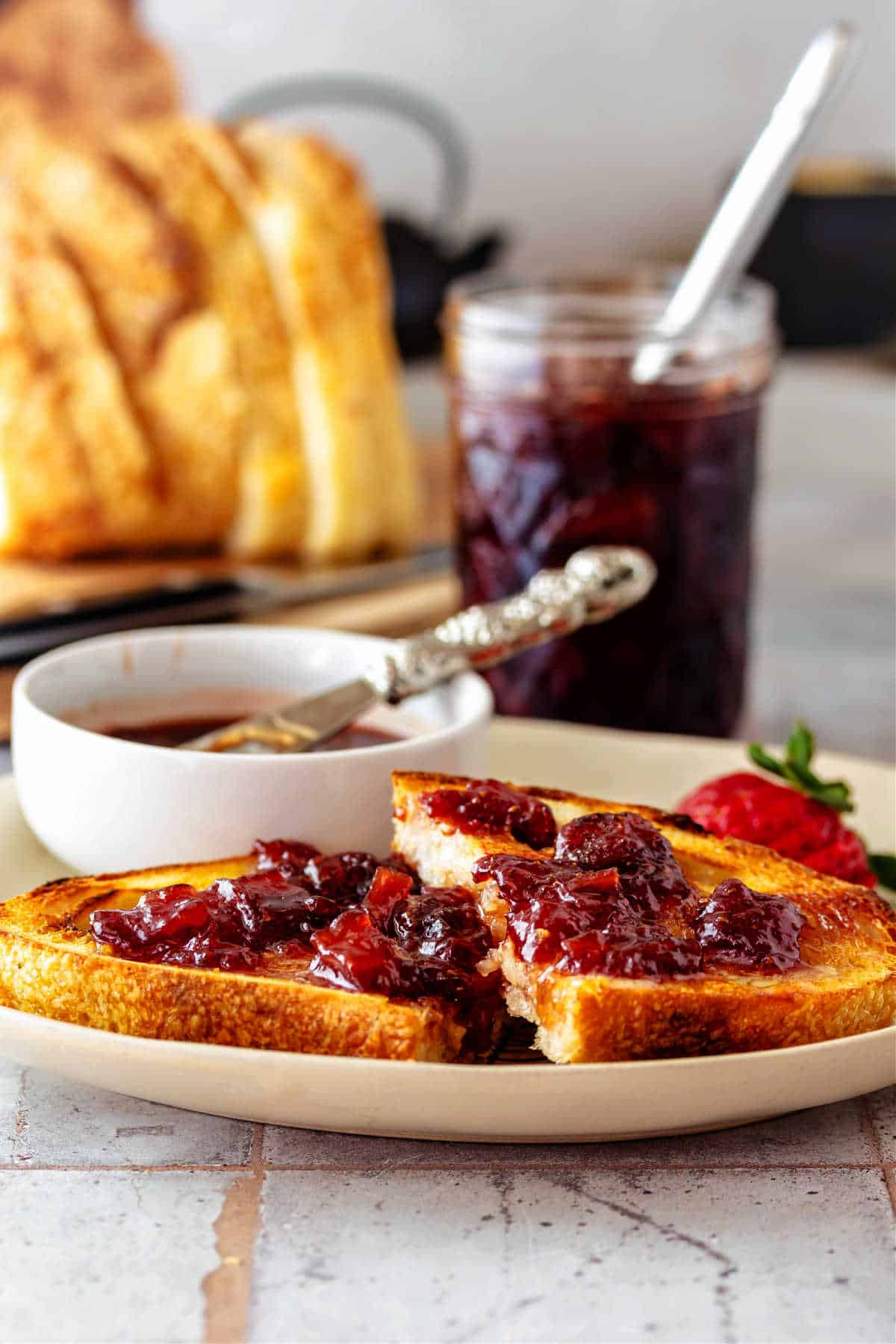
Join in Today!
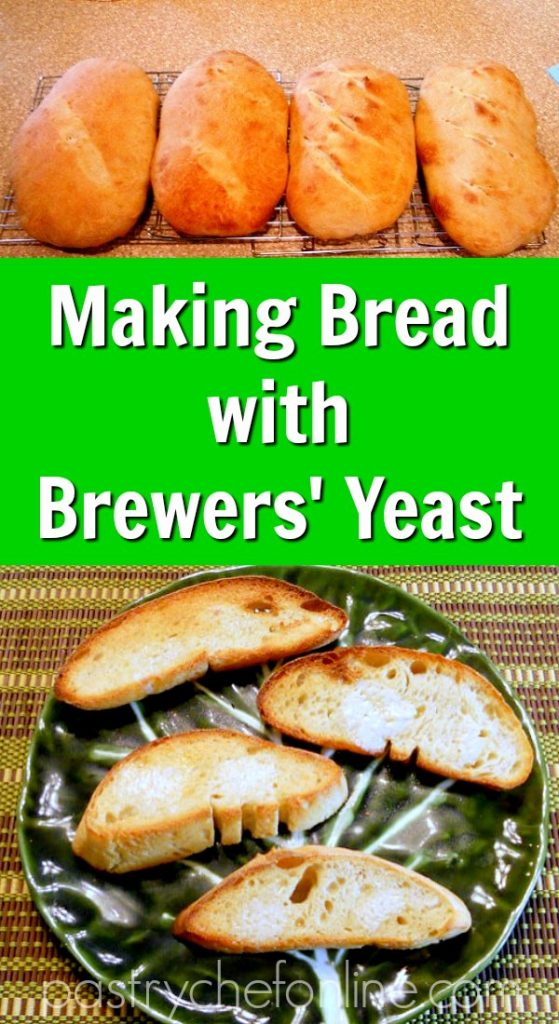


Tks Jenni God bless
Enjoy the bread, Joe. Stay well. xo
Tks Jenni
Hello
What can I bake with left over sourdough?
Tks and God bless.
Hey, Joe! I don’t bake with sourdough, but if you are looking for recipes for what to do with the leftover starter when you feed it, that’s called “sourdough discard,” and I know many people use it in quick breads, pancakes, etc. Here are a couple of posts to start with: there are 3 recipes here for waffles, pancakes, and quick bread: https://www.theperfectloaf.com/my-top-3-leftover-sourdough-starter-recipes/ and this post has a cracker recipe https://www.loveandoliveoil.com/2019/03/sourdough-crackers-with-olive-oil-herbs.html Hope that helps!
Hi Jenni, I came here for the same reason as Nancy! I managed to get Nottingham yeast for my parents to bake their bread and I was so happy to find your post. Am I reading right that you only used 1/4 teaspoon of yeast for almost 500 g flour? It seems that 1/4 tsp of yeast is less than 1 g, and the whole packet is 11g, so 11 breads from the whole packet, is that right? I was thinking more like half a lacket for 500g flour so only 2 breads from 1 packet… I appreciate if you could help me understand your proportions.
Yes, you read it correctly, Joanna. But of course you can use more. I wanted a super long, slow rise, and using that tiny amount of yeast did it for me. If you want to speed the process along, use a teaspoon or 1 1/2 and have a more “normal” rising schedule of maybe 2-3 hours for the first, then shape and let proof again for an hour or so. You don’t have to do the retard in the fridge either. These days, you want bread fast, so just go for it with a bit extra yeast in the mix.. I hope you enjoy it.
If you do want to make the yeast last, you can absolutely use the tiny amount I used. But just know it’ll take it quite a while to really get going.
Take care, and I hope this helped. 🙂
Just a note to say that Nottingham yeast is an ale yeast, not lager. It will do better if you don’t chill it!
Hi and thanks for checking in. I know that Nottingham is an ale yeast, but I treated all four pieces of dough exactly the same way. Refrigeration usually retards the rise, and I noted that the lager yeast stayed much more active in the fridge than did the other three yeasts. Even were I to use only Nottingham yeast to make bread, I most likely would still give it a nice overnight in the fridge to develop flavor and chew, especially since it will “wake up” again once I take it out and it warms up. I guess a logical experiment using only Nottingham would be to divide the dough in two, making one loaf on a day without any refrigeration and giving the other an overnight chill and then see if there is any difference in the two loaves. Hmmm… =) Thanks again for stopping by!
I searched ‘net for this kind of experiments, and was glad there’s others interested in using beer yeast in baking. Just for this week, I tried to expand volume of yeast gathered from the bottom of the commercial beer bottle. It seemed to succeed, and I created sourdough from about a litre of yeast and flour mixture. Bread rised well during baking, and had a delicious crust. I think I’ll repeat what I learned and maybe publish what the process yielded.
Wow–love that you used “collected” yeast from the bottle. I’d love to see photos of your results if you feel like sharing. You can email to onlinepastrychef at yahoo dot com or post them to the “Jenni Field’s Pastry Chef Online” facebook page. Thanks so much for stopping in, Michael!
My husband has just started brewing beer, he first gave me leftover yeast and now he’s giving me spent grains. Do you think I could work some of the spent grains into the recipe? I had to dry them because I couldn’t come up with a recipe fast enough to use them wet.
I think you can, but I might try soaking them first with a portion of the liquid. When dried they are so scratchy that I’d be afraid they’d cut too much of the gluten. A nice soak in warm water or even mild beer should help with that. =)
PS: spent grains freeze really well, so next time just freeze them wet and thaw when you’re ready to bake!
I’m a brewer and I currently have a batch of cider brewing using the wild yeasts from the skin of the apples. I might try and replicate one of your loaves using my dregs when this cider gets finished, and see how different from a sourdough it is.
I love this idea, Ken! Please let me know how it goes!
Can this bread be made using gluten free flour and still be good?
Honestly, Jean, I have no real idea. I don’t do substitution baking, so I’ve never tried to make a gluten free version. There are many experts who could help you, though. Janice Mansfield comes to mind: http://janicemansfield.com/ I do know that you can’t just substitute one gluten free flour for the AP that I used. Since you won’t have gluten for structure, that has to come from gums, such as xanthan gum. I do hope Janice will be able to help. At the very least, I’m sure she has some lovely gf bread recipes on her site. 🙂
Fantastic! I was just wanting to try out brewer’s yeast for bread and am so glad I found your thread. I, too, live near American Brewmaster and will go out there today. I bake a lot with various wild yeast cultures from around the world and have been considering trying to introduce a brewer’s strain into one of those cultures to see if some kind of symbiosis might be possible among the naturally occurring yeast/bacilli and a 2nd yeast. Perhaps because brewer’s yeasts aren’t supercharged like baker’s yeast they might not out-compete. Can’t wait to try! Thanks for the inspiration.
Hey, that sounds like a fantastic idea! If you do create some sort of hybrid Franken-yeast, please let me know. I’d love to hear about your results!
Some beers are bottle-conditioned- meaning live yeast and extra sugar are pitched into the bottle to start another fermentation. Since the yeast is still alive, I wonder if you couldn’t just substitute a bottle conditioned beer for the water AND yeast in your recipe, and if a proper rise could be achieved that way. Yeast tends to settle in the bottle, so I’d probably give it a good shake before attempting this.
That’s an interesting idea. My only concern about that would be that once the beer is carbonated via the bottle conditioning, most of the yeast would be killed off by the alcohol in the beer. On the other hand, I don’t see why you couldn’t give it a shot to see what would happen. Some of the yeasties might just be dormant and throwing them in with a bunch of new food would wake them up.
Maybe try an experiment where you drain off all the beer and then pour the sediment out into a cup with a bit of warm water and a pinch or two of sugar and let it sit awhile to see if the yeast will start eating. If so, full steam ahead! If you try it, let me know, @3108fcc1a480dcff2c76ad5b3f49257a:disqus . I’d be interested in hearing your results!
Thanks for this! I’d always assumed brewer’s and baker’s yeast were not exchangeable. Now you got me all excited to go to the homebrew shop!
It opened a whole new world of possibilities, bread-wise, @google-afd6a762b92a3db25cb94570e301aa5f:disqus ! Enjoy and experiment away! I’m thinking playing w/a champagne yeast and using some champagne *in* the dough would be fun!
Love the recipe you got here. It is very easy to follow. Very simple and yet have great results.
So cool! This totally lends credence to the B&B (Brewery and Bakery) idea that Nick and I have been nursing for a while now. So interesting to see how the different yeasts work – I can’t wait to do my own experiments with brewer’s yeast!
Camille, if you and Nick make the B&B happen, I am coming to the opening! Now that I’ve done some experimenting, I think the possibilities might actually be limitless. You must start playing immediately! 🙂
I didn’t know that you brew–did I? My husband is the home brewer in the family. The bread is great–you should seriously try using brewing yeast in bread! 🙂
So cool!! I love reading your posts normally, but as a home brewer to read how you used the different brew yeasts YUM!!! Thank you! ~ MJ Schrader